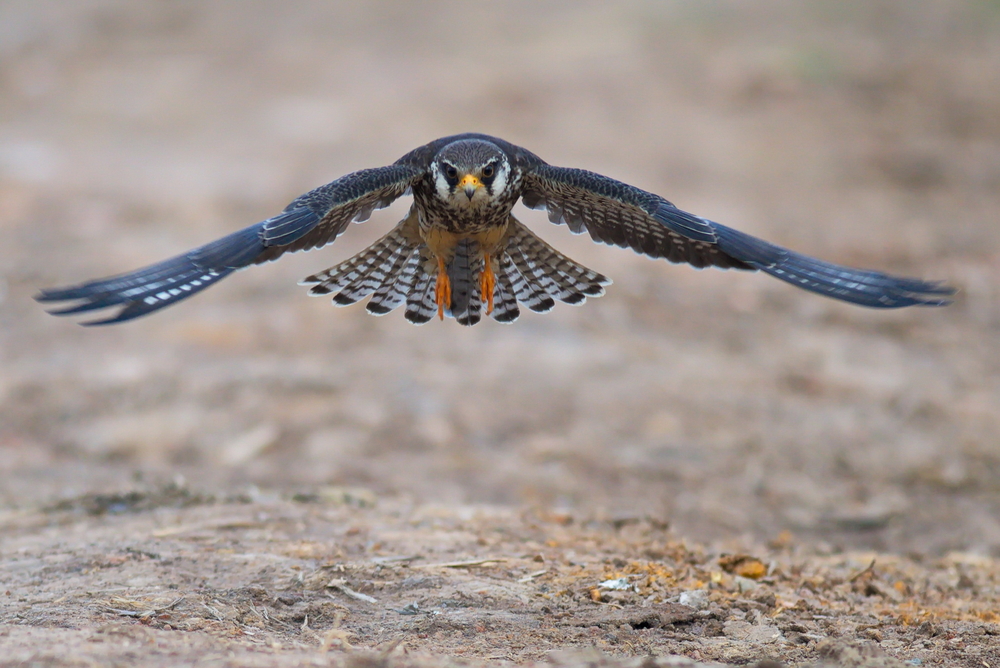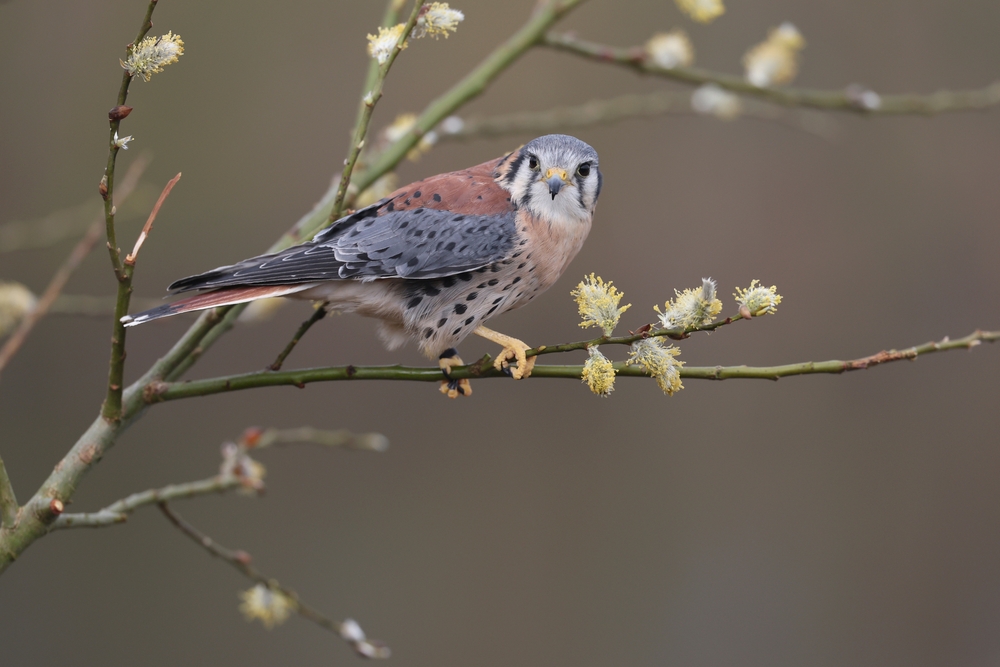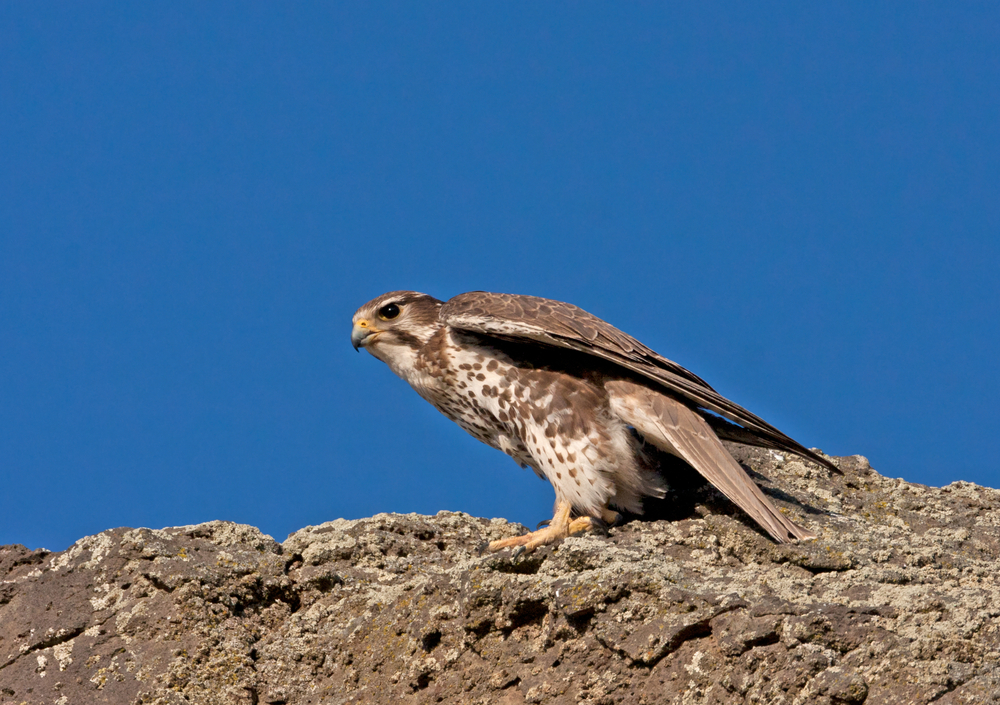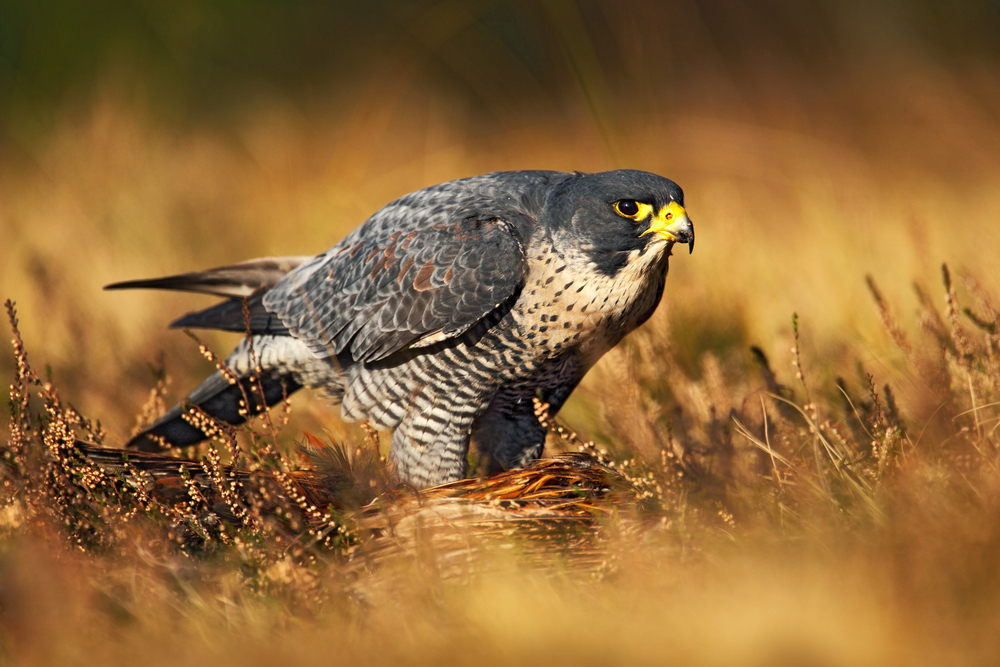The Amur Falcon (Falco amurensis) is most closely related to the Red-footed Falcon (Falco vespertinus) of Europe. Both species share similar size, plumage patterns, diets, and migratory habits.
About
The Amur Falcon (Falco amurensis) is a small migratory falcon of the Falconidae family, famed for its extraordinary long-distance journey. Breeding in southeastern Siberia, northern China, and Mongolia, it undertakes one of the most remarkable migrations of any bird, traveling across India, the Arabian Sea, and Africa to winter in southern and eastern Africa.
Measuring 27 to 30 centimeters (10.5 to 12 inches) in length with a wingspan of 63 to 71 centimeters (25 to 28 inches), the Amur Falcon is slender and elegant. Males are striking, with dark gray plumage, rufous thighs, and white underwings edged with black. Females are paler with barred underparts, a streaked breast, and an orange eye-ring. Juveniles resemble females but with more mottling. Their long, pointed wings and buoyant flight make them adept aerial hunters.
The Amur Falcon feeds primarily on insects, especially locusts, grasshoppers, and termites, often capturing them in flight. During migration and in wintering grounds, they gather in enormous communal roosts, sometimes numbering hundreds of thousands of birds—an awe-inspiring spectacle in Africa and India.
Breeding takes place in open forests and farmland, often using old nests of crows or other raptors. The female lays three to five eggs, which are incubated mainly by her while the male provides food. Both parents help raise the young until fledging.
Once heavily persecuted along migratory routes, particularly in India, conservation efforts and community awareness have dramatically reduced hunting pressure in recent years. The species is currently listed as Least Concern, with stable populations, though it remains vulnerable due to its reliance on safe stopover sites during migration.
With its incredible endurance, communal behavior, and reliance on global flyways, the Amur Falcon is a symbol of the interconnectedness of ecosystems across continents.
Physical Characteristics
The Amur Falcon (Falco amurensis) is a small, migratory falcon known for its remarkable long-distance flights and compact build.
Plumage:
-
Males: Slate-gray upperparts, pale gray underparts, and distinctive rufous thighs and undertail coverts. The wings are dark and pointed, and the face shows a subtle pale cheek.
-
Females: More streaked and patterned than males, with brownish-gray upperparts, pale underparts with dark streaking, and rufous thighs. Their plumage resembles that of juvenile kestrels but with a slimmer build.
-
Juveniles: Similar to females but paler, with more prominent streaking.
Head and Face:
The head is small and rounded with a sharp, hooked beak typical of falcons. Dark eyes provide excellent vision for hunting, and a faint facial pattern differentiates males from females.
Body and Wings:
Amur Falcons have a slender body with long, pointed wings designed for endurance flight. Their wing shape allows them to soar and maneuver efficiently during migration.
Tail:
The tail is medium-length and slightly rounded. It is dark gray in males, with subtle banding more visible in females and juveniles.
Size:
-
Length: 10–12 in (25–30 cm)
-
Wingspan: 24–27 in (61–69 cm)
-
Height at Rest: About 11 in (28 cm) when perched
Weight:
-
Adult Male and Female: 3.5–6.3 oz (100–180 g)
The Amur Falcon’s sleek form, long pointed wings, and lightweight build are specialized for long-distance migration, enabling it to travel thousands of miles between breeding grounds in Asia and wintering areas in southern Africa.
Reproduction
The reproductive cycle of the Amur Falcon (Falco amurensis) is closely tied to its long migrations, with breeding occurring in Asia during the summer months.
1. Mating and Courtship:
Amur Falcons are generally monogamous during the breeding season. Courtship involves aerial displays, vocalizations, and the male offering prey to the female. These behaviors strengthen the pair bond before nesting.
2. Nesting Sites:
Unlike many falcons, Amur Falcons do not build their own nests. They typically reuse the abandoned stick nests of crows, magpies, or other large birds, often located in trees or on cliffs.
3. Egg Laying:
The female lays 3–4 eggs per clutch, usually in May or June, after returning from migration. Eggs are cream-colored with reddish-brown speckles.
4. Incubation:
The incubation period lasts about 28–30 days, with the female doing most of the incubating while the male provides food.
5. Hatching and Care of Chicks:
Chicks hatch covered in pale down and are entirely dependent on their parents. The female broods them continuously at first, while the male hunts and brings food. As chicks grow, both parents participate in feeding.
6. Fledging and Independence:
Young falcons fledge at about 26–30 days old, gaining flight ability and beginning to practice hunting. After leaving the nest, juveniles remain near their parents for a short period before becoming independent.
7. Breeding Frequency:
Amur Falcons produce one brood per year, timed carefully so that chicks mature before the autumn migration to Africa.
The Amur Falcon’s reproductive strategy of reusing nests, laying moderate clutch sizes, and coordinating its breeding with migration ensures that it can thrive despite the challenges of long-distance travel.
Lifespan
The lifespan of the Amur Falcon (Falco amurensis) reflects the challenges of being a long-distance migratory raptor, with survival influenced by predation, weather, and human activity.
Lifespan in the Wild:
Amur Falcons typically live up to 12 years in the wild, though many do not survive their first year due to migration hazards, food scarcity, and predation. Average adult survival is considered moderate for small falcons.
Lifespan in Captivity:
In captivity, where food and shelter are secure and veterinary care is available, Amur Falcons can live slightly longer, reaching 14–16 years under proper care.
Threats to the Amur Falcon:
-
Predation: Eagles, larger hawks, and owls prey on both adults and chicks.
-
Migration Hazards: Their migration route across the Indian Ocean is perilous, requiring nonstop endurance flights of thousands of miles.
-
Hunting Pressure: In parts of their migratory path, especially historically in northeastern India, mass hunting posed a major threat (though now reduced by conservation efforts).
-
Habitat Loss: Decline of open woodlands and wetlands reduces suitable breeding and feeding areas.
-
Climate Change: Changing wind patterns and insect availability can disrupt migration success and breeding timing.
Conservation measures, including protecting migratory stopover sites and reducing hunting pressure, are vital to sustaining Amur Falcon populations across their vast migratory range.
Eating Habits
The Amur Falcon (Falco amurensis) is an agile aerial hunter with a diet strongly tied to insect availability, particularly along its long migratory routes.
Diet:
-
Insects: Dominates their diet, especially dragonflies, locusts, grasshoppers, beetles, and termites.
-
Small Vertebrates: Occasionally consume small rodents, lizards, frogs, or small birds, especially during the breeding season.
-
Migratory Feasting: During stopovers in India and Africa, they gather in huge flocks to feed on insect swarms, especially locusts and termites.
Hunting Strategy:
-
Aerial Hunting: They are skilled at catching insects mid-flight, using swift, acrobatic maneuvers.
-
Perch-Hunting: From treetops, powerlines, or open perches, they launch into quick chases after spotting prey.
-
Mass Feeding: During migration, they sometimes forage in large communal flocks, taking advantage of insect outbreaks.
Feeding Behavior:
-
Prey is typically consumed on the wing or carried to a perch.
-
During breeding, males capture and deliver food to females and chicks, often passing prey directly in mid-air.
-
They adjust their diet seasonally—focusing on insects in summer and adding more vertebrates during breeding when protein demands are higher.
Success and Adaptability:
The Amur Falcon’s reliance on insects makes it highly effective at pest control, especially during agricultural outbreaks of locusts and grasshoppers. Its adaptability to different food sources across continents is a key factor in its survival during one of the longest migrations of any raptor.
Uniqueness
The Amur Falcon (Falco amurensis) is an extraordinary small falcon with several traits that make it stand out among raptors.
Epic Migration:
One of the most remarkable features of the Amur Falcon is its long-distance migration. Every year, it travels up to 14,000 miles (22,000 km) round trip, breeding in northeastern Asia (China, Mongolia, Russia) and wintering in southern Africa. This includes a nonstop flight of more than 1,800 miles (3,000 km) across the Indian Ocean.
Mass Roosting Behavior:
During migration, particularly in India and Africa, tens of thousands of Amur Falcons gather in communal roosts, creating some of the largest raptor flocks in the world.
Dietary Specialization:
Unlike many falcons, Amur Falcons rely heavily on insects—especially locusts and dragonflies—making them crucial allies in controlling agricultural pests.
Sexual Dimorphism in Plumage:
Males and females differ noticeably in appearance. Males are slate-gray with rufous thighs, while females are more streaked and barred, resembling juvenile kestrels.
Cultural and Conservation Significance:
Once heavily hunted during migration through northeastern India, the species has become a symbol of successful conservation. Local and international efforts have drastically reduced hunting, turning the falcon into a celebrated species for community-based wildlife protection.
Adaptability Across Continents:
From Asian breeding grounds to African wintering areas, the Amur Falcon thrives in varied habitats, including grasslands, wetlands, and agricultural landscapes.
The Amur Falcon’s combination of record-breaking migration, mass social gatherings, insect-driven diet, and conservation success story makes it one of the most fascinating falcons on Earth.
Be the First to Share Photos of This Species.
FAQ’s
1. What is the species closest to the Amur Falcon?
2. How does the Amur Falcon compare to other falcons?
Unlike larger falcons such as the Peregrine, the Amur Falcon is small, lightweight, and insect-dependent. Its endurance-based migration across continents distinguishes it from most falcons, which tend to be territorial rather than highly social travelers.
3. Which national parks provide the best opportunities to see an Amur Falcon?
Amur Falcons are best seen in migratory stopovers and wintering grounds. Key locations include:
-
Kaziranga National Park (India): Known for massive migratory roosts in northeastern India.
-
Kruger National Park (South Africa): A prime wintering site where flocks can be observed feeding on insects.
-
Etosha National Park (Namibia): Open savannas provide excellent opportunities to see wintering falcons.
-
Khingan Nature Reserve (Russia/China border): Important breeding grounds in northeastern Asia.






































































